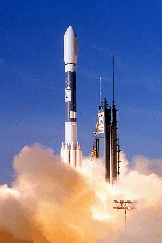For hundreds of years astronomers observed the Universe using
only the visible light our eyes can see. However, visible light,
spanning 3500 to 7000Å, is a tiny portion of a much
broader range of light energy known as the electromagnetic
spectrum, which includes everything from energetic X-rays and gamma rays
to infrared radiation and radio waves. Much
of this "invisible" light
gets blocked by the Earth's atmosphere, but in the last forty years astronomers
have been using telescopes above the atmosphere to obtain entirely different perspectives
on the Universe. A new perspective, one that has only
been glimpsed a few times before,
will be provided by a NASA telescope known as the Far Ultraviolet Spectroscopic
Explorer (FUSE).
 FUSE, 5.5 metres long and weighing 1.4 tonnes, was launched into low
Earth orbit aboard a Delta II rocket (see right) on 24 June 1999 for
three years of operations. FUSE will explore the Universe through
high-resolution
spectroscopy, which disperses the light out, so that it can be analysed in
great detail (delta lambda/lambda= 24,000-30,000), at far ultraviolet
wavelengths (905-1195Å), largely inaccessible to other
telescopes. FUSE will address fundamental questions related to
the origin and evolution of the universe.
FUSE, 5.5 metres long and weighing 1.4 tonnes, was launched into low
Earth orbit aboard a Delta II rocket (see right) on 24 June 1999 for
three years of operations. FUSE will explore the Universe through
high-resolution
spectroscopy, which disperses the light out, so that it can be analysed in
great detail (delta lambda/lambda= 24,000-30,000), at far ultraviolet
wavelengths (905-1195Å), largely inaccessible to other
telescopes. FUSE will address fundamental questions related to
the origin and evolution of the universe.
 FUSE, 5.5 metres long and weighing 1.4 tonnes, was launched into low
Earth orbit aboard a Delta II rocket (see right) on 24 June 1999 for
three years of operations. FUSE will explore the Universe through
high-resolution
spectroscopy, which disperses the light out, so that it can be analysed in
great detail (delta lambda/lambda= 24,000-30,000), at far ultraviolet
wavelengths (905-1195Å), largely inaccessible to other
telescopes. FUSE will address fundamental questions related to
the origin and evolution of the universe.
FUSE, 5.5 metres long and weighing 1.4 tonnes, was launched into low
Earth orbit aboard a Delta II rocket (see right) on 24 June 1999 for
three years of operations. FUSE will explore the Universe through
high-resolution
spectroscopy, which disperses the light out, so that it can be analysed in
great detail (delta lambda/lambda= 24,000-30,000), at far ultraviolet
wavelengths (905-1195Å), largely inaccessible to other
telescopes. FUSE will address fundamental questions related to
the origin and evolution of the universe. 